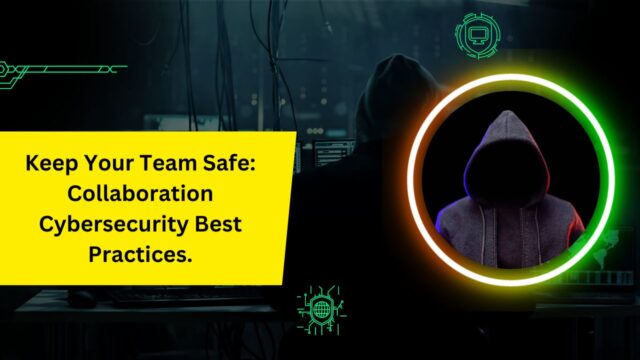The use of cloud-based solutions has become a transformative force for enterprises in the modern digital collaboration landscape, providing unmatched flexibility and efficiency. But this shift to a more dynamic and networked work environment necessitates a strong and flexible cybersecurity plan as well. It is crucial for enterprises to comprehend the subtleties of protecting sensitive data in cloud-based collaboration platforms as they set out on this journey. The goal of this extensive guide is to offer a full examination of important cybersecurity advice to guarantee the safe use of these products.
Cybersecurity Tips for Safeguarding Your Collaboration Tools:
Choose Trusted Platforms:
The foundation of any cloud collaboration cybersecurity strategy is the thoughtful selection of platforms. Choosing reliable and well-established providers is like bolstering your first line of protection. These platforms frequently make significant investments in state-of-the-art security measures and frequent updates because they have a history of placing a high priority on security, compliance, and adherence to industry standards. Organizations build a solid basis for a safe and secure collaboration environment by partnering with such providers.
Data Encryption:
A strong protection system is required when sending sensitive data over the cloud. An essential defense is end-to-end encryption, which makes intercepted data unintelligible without the right decryption key. Organizations that use this encryption strengthen the confidentiality of sensitive data by ensuring that it stays safe even in the event of illegal access during transmission.
Also Read: The Evolution of Cybersecurity and AI
User Authentication and Access Control:
A key component of the cloud collaboration paradigm is fortifying the access control gates. When combined with multi-factor authentication (MFA), robust user authentication creates a strong barrier against unwanted access. MFA provides an additional degree of protection by asking users to present several sources of identity. At the same time, putting in place fine-grained access controls that correspond with roles and responsibilities acts as a precision instrument, restricting user access to certain data and so reducing the possible consequences of security breaches.
Regularly Update and Patch:
The digital environment is ever-changing, and flaws in systems and software are always being found and fixed. Frequent patches and upgrades act as an organizational defense against known vulnerabilities, lowering the possibility that cybercriminals may take use of them. By minimizing the window of exposure to potential hazards, configuring automated updates wherever possible guarantees a proactive approach to system maintenance.
Data Backups:
Recognizing that possible data breaches are inevitable, organizations need to strengthen their defenses with solid contingency plans. Maintaining regular data backups becomes strategically necessary to make sure that the firm can quickly recover without compromising important information in the event of a breach or data loss. The organization’s resilience is increased by the additional layer of redundancy that comes from combining offline and cloud-based backup systems.
Continuous Monitoring and Auditing:
To quickly identify security incidents and take appropriate action, it is essential to have strong monitoring and auditing procedures. Real-time monitoring keeps tabs on users’ activities using collaborative technologies and flags any questionable activity. Frequent audits assist preserve compliance with security policies and laws by offering insightful information about how well security procedures are working.
Educate Users on Cybersecurity Best Practices:

User education is essential to a comprehensive cybersecurity strategy since human error is still a major cybersecurity risk. Conduct training sessions on a regular basis to inform users on security best practices. Make sure to emphasize the value of creating strong passwords, how to spot phishing efforts, and how to report suspicious activity right away. The overall security posture is improved by cultivating a culture of cybersecurity awareness.
Vendor Security Assessment:
Since third-party vendors frequently supply collaboration solutions, a careful assessment of their security protocols is required. Verifying compliance with the organization’s strict security criteria is ensured by performing a thorough security assessment of the vendor. Assessing the collaboration tool provider’s security protocols, data protection guidelines, and compliance certifications offers valuable information about their credibility.
Incident Response Plan:
To lessen the effects of a security issue, a thorough incident response plan must be created. Establish communication procedures, clearly define roles and duties, and carry out frequent drills to guarantee a prompt and efficient response to possible threats. An incident response strategy that has been carefully thought out is essential to reducing the effects of a security compromise.
Adherence to Regulatory Standards:
It is essential to make sure that companies with strict regulatory frameworks comply with standards like GDPR, HIPAA, or ISO 27001. Respecting these guidelines is essential to preserving data security and privacy in addition to being required by law.
Secure File Sharing Procedures:
To avoid inadvertently disclosing private information, safe file-sharing procedures must be put in place. Make use of tools like access controls, password-protected sharing, and shared link expiration dates to restrict file access to just those who are permitted. These steps support data security when working together.
Secure Integration with Other Tools:
It’s critical to guarantee the security of any integrations that collaboration tools have with other programs. Evaluate third-party apps’ and services’ security protocols in detail to guard against security holes that could be used to obtain unwanted access.
Conclusion:
Setting cybersecurity as a top priority is now essential as businesses navigate the constantly changing world of cloud-based collaboration. Organizations may protect sensitive data, create a safe collaboration environment in the cloud, and bolster their cybersecurity strategy by implementing the previously given recommendations. Staying ahead of new threats and maintaining the effectiveness of the cybersecurity strategy require regular reassessment and updating of security measures. An all-encompassing and proactive approach to cybersecurity when traversing the cloud is essential for a safe and secure digital future.
